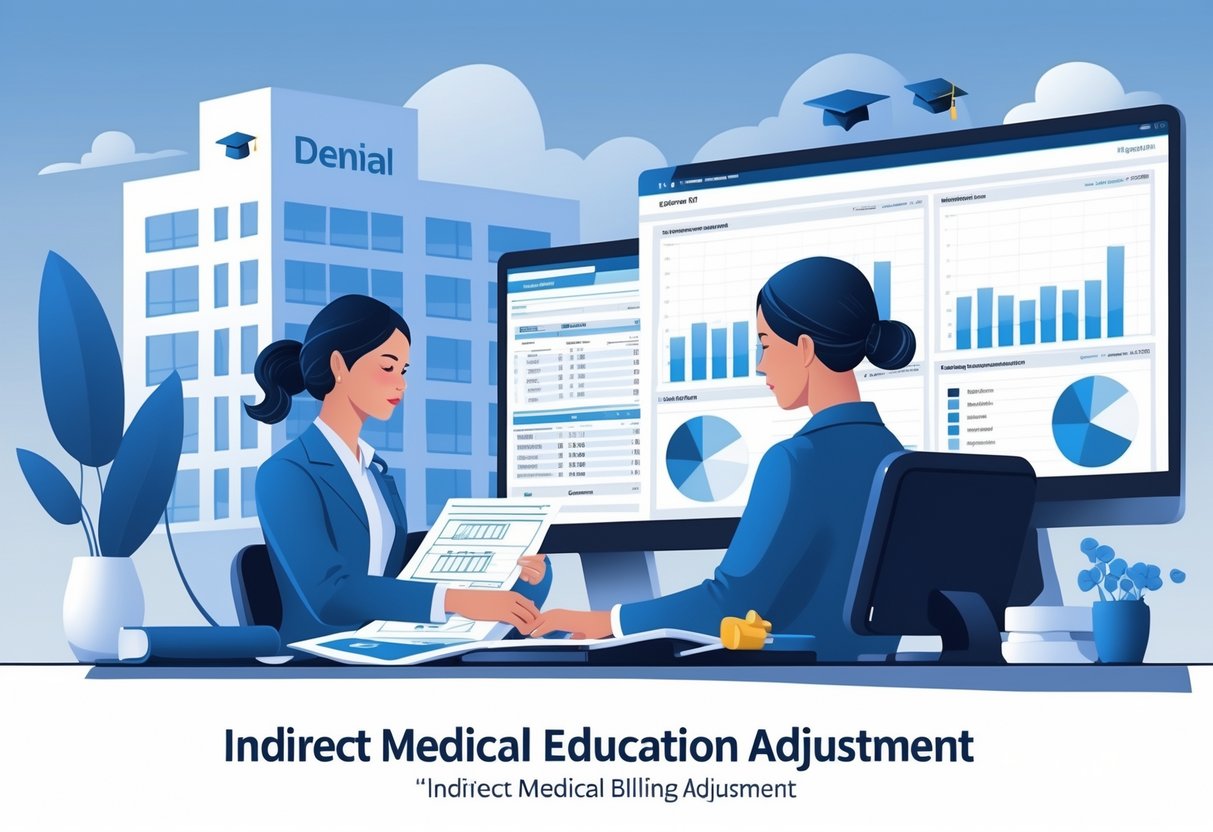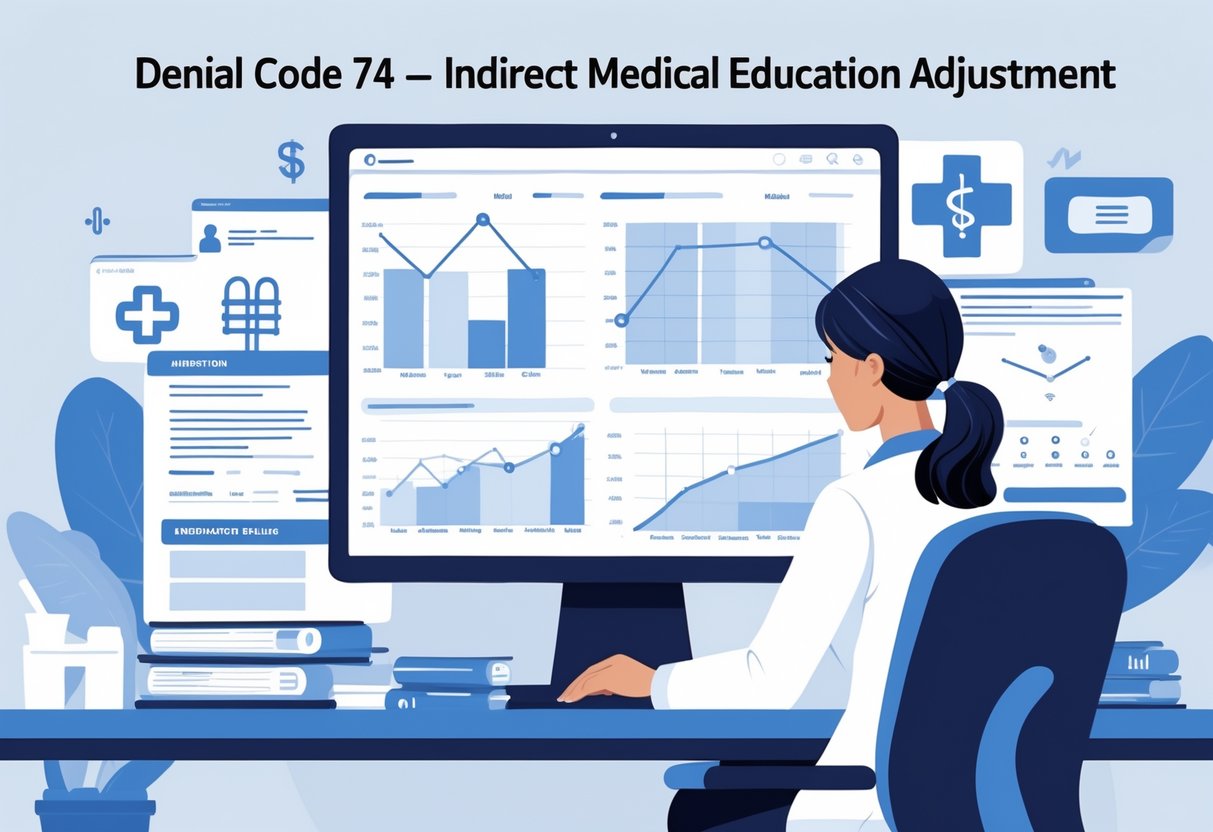Denial code 74 relates to the Indirect Medical Education (IME) adjustment. This denial happens when Medicare reduces payments to reflect the extra teaching costs hospitals face, but your claim did not follow the rules for these adjustments. Understanding why this happens can help you avoid denied claims and improve your billing process.
You might see this denial if your hospital or provider location qualifies for IME but your claim lacks proper details or uses the wrong codes. Knowing what triggers denial code 74 lets you catch errors early and fix them before resubmission.
If you handle medical billing or manage hospital claims, you need to understand how this adjustment works. It clarifies why Medicare lowers payments and what you can do to meet their requirements.
Understanding Denial Code 74

Denial Code 74 relates to adjustments made for indirect medical education costs. You will learn what this code means, when it shows up on claims, and the main terms connected to it.
Definition and Purpose
Denial Code 74 means your claim was denied because of an indirect medical education adjustment. This adjustment affects payments to hospitals teaching medical students. It covers extra costs hospitals have when they train future doctors.
This code ensures payments reflect those training costs correctly. It is part of Medicare billing rules. If your claim includes this code, it usually means payment was reduced due to education-related factors.
When Denial Code 74 Occurs
You will see Denial Code 74 when a hospital claim involves indirect medical education costs. It happens mainly with inpatient hospital services billed to Medicare. The claim payment may be adjusted or reduced.
This denial can occur if the claim does not meet certain Medicare requirements. It might be related to the way education adjustment calculations were applied. Sometimes, additional documentation is needed to explain the indirect medical education costs.
Key Terminology Explained
Indirect Medical Education (IME): Extra costs hospitals have when they train medical residents.
Adjustment: A change made to the payment amount on a claim.
Denial Code: A numeric code that explains why a claim or part of it was denied.
Medicare: A federal health insurance program for people 65 and older or with certain disabilities.
Knowing these terms helps you understand why Denial Code 74 appears and what it aims to address.
Indirect Medical Education Adjustment Criteria

You need to understand the rules for who qualifies, how the amount is figured, and any recent updates. This will help you navigate the Indirect Medical Education (IME) adjustment process with accurate details.
Eligibility Requirements
To get the IME adjustment, your hospital must participate in Medicare’s Graduate Medical Education (GME) program. You must have a set number of full-time residents in approved training programs.
Only hospitals with direct GME payments can qualify for IME adjustments. Your hospital’s status as a member of the Medicare program and the teaching intensity affect eligibility.
Your hospital must report accurate resident counts and maintain proper documentation. Failure to do so may result in denial code 74 or other payment issues.
Calculation Factors
The IME adjustment is based on your hospital’s ratio of residents to beds, called the teaching intensity ratio. This ratio impacts how much extra Medicare pays for indirect educational costs.
The formula involves a fixed multiplier set by Medicare and a power factor related to your teaching intensity. This means even small increases in residents can lead to bigger payment adjustments.
Patient mix, hospital size, and regional cost differences do not directly affect the IME adjustment amount. Focus on keeping resident numbers and bed counts accurate to avoid payment errors.
Recent Changes in Criteria
Recent rule changes have clarified the resident count period and how part-time residents are converted into full-time equivalents. This can change your teaching intensity ratio.
Medicare has also updated the payment formulas to better reflect current hospital training costs. These updates may slightly increase or decrease the IME adjustment depending on your hospital’s profile.
New data reporting requirements now require timely submission of resident information. Missing deadlines may cause delays or denials under code 74. Staying current with these rules protects your payments.
Common Reasons for Denial Code 74
Denial code 74 often happens when submitted claims don’t meet specific Medicare rules for Indirect Medical Education (IME) adjustments. Issues usually stem from missing information, mistakes in how you bill, or failing to follow Medicare’s detailed guidelines correctly.
Documentation Errors
One frequent reason for denial is incomplete or inaccurate documentation. If your records don’t clearly show the required patient information or hospital teaching details, Medicare might reject the IME adjustment.
You need to include admission dates, patient status, and proof of teaching hospital involvement. Missing or inconsistent data makes it hard for reviewers to verify your claim.
Always check your documents for accuracy before submitting a claim. Keeping detailed notes on teaching staff participation is key to avoiding denial code 74 due to documentation errors.
Incorrect Billing Practices
Billing mistakes can trigger denial code 74 too. This includes using wrong codes or failing to link the IME adjustment properly on the claim.
For example, if you don’t add the right modifier or use outdated ICD codes, Medicare may deny the payment. Make sure you understand which codes apply to your hospital and services.
Double-check your billing system to ensure all necessary adjustments for indirect medical education are included. Avoid shortcuts that might seem simpler but can cause claim rejections.
Non-Compliance with Medicare Guidelines
Medicare sets strict rules on how IME payments are made. If you don’t follow these rules exactly, your claims may be denied.
Examples of non-compliance include not submitting claims within the time set by Medicare or failing to meet the hospital teaching program requirements. You must track and report all required teaching activities accurately.
Review Medicare’s official guidelines regularly. Being up-to-date helps you avoid denials linked to non-compliance issues.
Resolving Denial Code 74 Issues
You need to follow a careful process to appeal the denial and gather the right documents. Timing is important to avoid delays or losing your chance to appeal. This section covers practical steps for handling Denial Code 74.
Step-By-Step Appeals Process
First, review the denial letter carefully to understand why your claim was denied. Then, write a clear appeal letter explaining why you believe the payment should be approved. Include specific references to the Indirect Medical Education Adjustment policies.
Next, submit the appeal through the payer’s designated system, either online or by mail. Keep copies of everything you send.
If the payer requests more information, respond quickly with the needed details. Track your appeal status regularly. If denied again, check if you can request a second-level appeal or mediation.
Supporting Documentation Needed
You must provide detailed documents to support your appeal. This includes your original claim forms and any corrected claims addressing the denial reasons.
Attach proof that your facility qualifies for Indirect Medical Education Adjustment. This might include your teaching hospital certification, residency program information, or financial reports showing education costs.
Also, add any correspondence or notes from your medical billing team explaining how you calculated the adjustment. Clear, organized paperwork improves your chance of approval.
Timelines for Resolution
Act quickly after receiving the denial; most payers set a deadline of 30 to 60 days to file an appeal. Missing the deadline can result in losing your right to challenge the denial.
After submitting your appeal, expect a response within 45 to 90 days. If you don’t hear back, follow up immediately to check the status.
Be aware that some cases may take longer if more documentation is requested or if you move to a higher level of appeal. Plan accordingly to manage your cash flow during this time.
Best Practices to Prevent Future Denials
You can reduce denial code 74 issues by focusing on staff knowledge and careful reviews of your billing and documentation. Training your team on specific requirements and regularly checking your records helps catch errors early.
Staff Training Strategies
Train your billing and coding staff on the details of Indirect Medical Education (IME) adjustments. Make sure they understand when these adjustments apply and how they affect claims. Use real examples from your own claims to show common mistakes.
Regular refreshers keep your team up to date with rule changes. Consider creating easy-to-follow guides or checklists focused on IME requirements. This approach reduces errors related to misunderstanding the rules or missing critical information.
Encourage questions and offer feedback during training sessions. A well-informed team can spot issues before submission, lowering the chance of denials.
Audit and Review Procedures
Set up routine audits of claims involving IME adjustments. Review denial reasons closely to spot patterns or recurring mistakes in your documentation or billing. This helps you address errors quickly before they become bigger problems.
Use a simple tracking system to monitor denials related to code 74. Compare your billing data with patient records to ensure accuracy. Catch mismatches between your documentation and billing codes early.
Involve multiple team members in the review process. Fresh eyes may find discrepancies others miss. Auditing regularly creates a stronger process and reduces future denial risk.
Frequently Asked Questions
Denial code 74 often affects how hospitals get paid for indirect medical education costs. You will need to know how to fix claims, find the right documents, and understand common cases where this denial happens.
What are the implications of denial code 74 on hospital billing processes?
Denial code 74 reduces the payment hospitals receive for education expenses. This may cause delays in reimbursement and extra work to correct claims.
It can also affect cash flow and the accuracy of billing reports.
How can providers correct or avoid indirect medical education adjustment denials?
You should double-check that your claims include the proper education adjustment codes.
Make sure you follow payer rules closely and update billing systems to reflect current policies.
What specific documentation is necessary to dispute a denial code 74?
You need to provide detailed records showing the hospital’s teaching activities.
Submit supporting financial data confirming your education costs and related adjustments.
Are there any common scenarios in which denial code 74 is typically applied?
This denial often happens when providers miss including the indirect medical education adjustment in claims.
It can also occur if billing does not match patient care dates tied to teaching services.
What steps should be taken when first receiving a denial code 74 on a claim?
Review the claim for missing or incorrect education adjustment information.
Contact the payer to understand the denial reason and gather any requested documents.
Can denial code 74 be prevented through the initial claim submission, and if so, how?
Yes. Ensure your billing system properly codes all indirect medical education costs before submission.
Stay updated on payer guidelines to avoid common mistakes.







